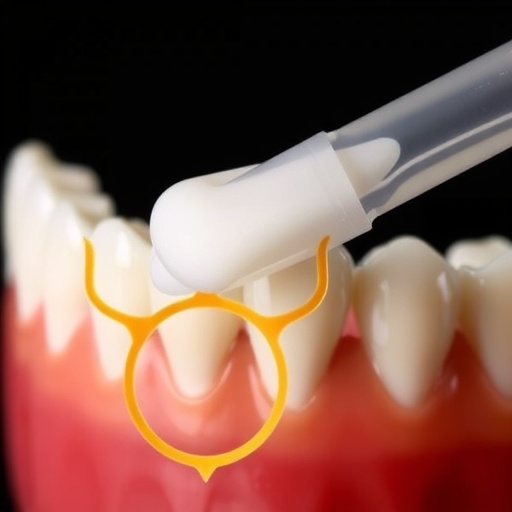Recent advancements in cosmetic dentistry highlight a crucial intersection between dental aesthetics and biochemical protection. Dental bleaching, a popular procedure aimed at enhancing the brightness of teeth, often raises concerns regarding the integrity of dental materials and tooth health post-procedure. A pivotal study by Prieto and colleagues sheds light on the protective mechanisms of ellagic acid in mitigating the potential damage associated with dental bleaching. This research introduces a paradigm shift in preventive strategies, particularly for those who frequently undergo aesthetic dental treatments.
Ellagic acid, a polyphenolic compound found abundantly in various fruits and nuts, is renowned for its antioxidant properties. The study conducted by the team reveals that ellagic acid plays a significant role in protecting the adhesive interface within the dental structure post-bleaching. This is particularly important as bleaching agents can alter the chemical composition of dental materials, leading to compromised adhesion and structural integrity. By integrating ellagic acid into post-bleaching care, dental professionals may significantly enhance the longevity of dental restorations.
During the bleaching process, various agents, particularly those containing hydrogen peroxide, have been shown to erode the adhesive qualities of dental materials. The adverse effects of these bleaching agents include reduced bonding strength of adhesives and increased porosity in the enamel and dentin. These changes not only affect aesthetic outcomes but can also lead to greater susceptibility to decay and sensitivity. The introduction of ellagic acid into the adhesive interface offers a targeted approach to counteract these detrimental effects.
The research conducted by Prieto et al. explores how ellagic acid, when applied immediately after bleaching, can reinforce the adhesive interface. Their findings suggest that ellagic acid interacts with the bonding agents and provides a layer of protection against enzymatic degradation while also neutralizing free radicals produced during the bleaching process. This interaction not only promotes better adhesion but also enhances the overall resilience of the dental structure against potential future interventions.
Another crucial factor discussed in the study is the timing of ellagic acid application. The researchers highlight that immediate application following bleaching yields optimal protective effects. This pointed approach ensures that the adhesive interface is shielded from the oxidative stress that follows chemically induced alterations from bleaching agents. The precise timing of intervention could revolutionize post-bleaching protocols and enhance treatment outcomes for patients.
Furthermore, the study delves into the biochemical pathways activated by ellagic acid, emphasizing its role as an antioxidant powerhouse. By scavenging harmful free radicals, ellagic acid mitigates oxidative stress within the dental microenvironment. This could potentially extend the lifespan of dental restorations while also promoting healthier tissue responses. These insights resonate with ongoing discussions in the field of dentistry regarding biocompatible materials and the necessity for protective measures in aesthetic dentistry.
Implications of such findings extend beyond clinical dental practices into the broader scope of patient education. With increasing awareness of the chemical impacts of dental procedures, patients are becoming more proactive in seeking solutions that align with their health concerns. Dentists and dental hygienists can therefore leverage this information in discussions with patients regarding the safety and efficacy of post-bleaching treatments.
Moreover, as the dental industry moves towards more sustainable practices, the use of natural compounds like ellagic acid can provide a dual benefit by promoting dental health while minimizing the reliance on synthetic chemicals. This shift aligns with current trends in holistic and preventive healthcare, where involving natural substances in therapeutic processes is gaining traction.
In conclusion, the pioneering work of Prieto and colleagues underscores a potentially transformative approach to post-dental bleaching care through the utilization of ellagic acid. This study not only elucidates the biochemical interactions at play but also posits actionable strategies for improving patient outcomes. As dentistry continues to evolve, integrating such protective measures will undoubtedly enhance the overall patient experience, paving the way for safer and more effective aesthetic treatments.
The future of dental aesthetics will likely hinge on such innovative research. Through ongoing exploration and validation of natural compounds like ellagic acid, the dental community is poised to redefine standard practices and enhance patient care comprehensively. More research is essential to further elucidate the mechanisms at work and to explore other potential applications of polyphenols in dentistry. The implications of this study are just the beginning of what could lead to a new era in dental restorative strategies.
In a world where dental aesthetics are paramount, safeguarding the health of dental materials and the overall integrity of dental work must remain a priority. The work of Prieto et al. serves as an important reminder of the need for ongoing research and practical applications that prioritize both beauty and safety in cosmetic dentistry. Whether for everyday consumers or professional practitioners, the harmonious blend of aesthetics and science will ultimately shape the future of dental care.
In light of these findings, dental professionals are encouraged to consider incorporating ellagic acid in post-bleaching care protocols, ensuring a holistic approach to patient treatment. As this field continues to advance, the coupling of nature with clinical practice is not only advantageous but may very well be essential in achieving optimal results.
The revelation of ellagic acid’s role in enhancing dental adhesion after bleaching signifies an exciting crossroads in dental research and clinical application that merits further exploration and discussion among the scientific and dental communities.
Subject of Research: Protective role of ellagic acid in dental aesthetics, focusing on adhesive interfaces after bleaching.
Article Title: Protective role of ellagic acid in the adhesive interface after dental bleaching.
Article References:
Prieto, L.T., Câmara, J.V.F., Pierote, J.J.A. et al. Protective role of ellagic acid in the adhesive interface after dental bleaching.Sci Rep 15, 38989 (2025). https://doi.org/10.1038/s41598-025-26885-2
Image Credits: AI Generated
DOI: https://doi.org/10.1038/s41598-025-26885-2
Keywords: Dental bleaching, ellagic acid, adhesive interface, antioxidants, polyphenols, dental aesthetics, chemical reactions, preventive strategies, dental materials.




